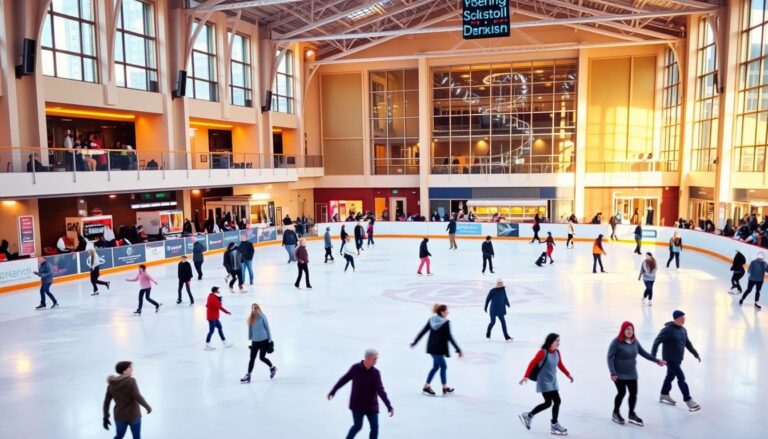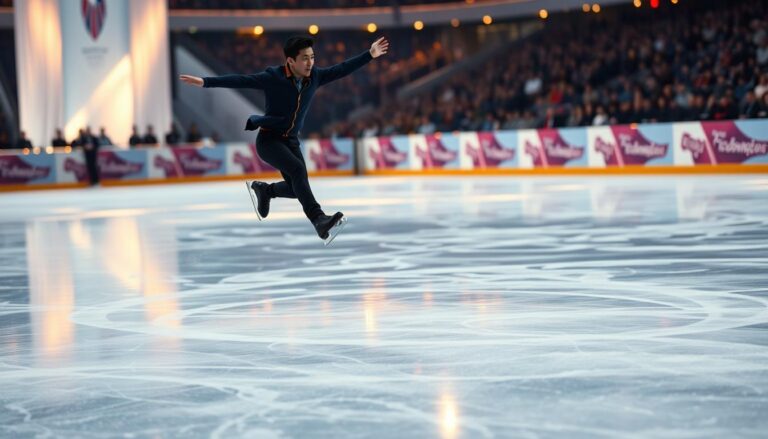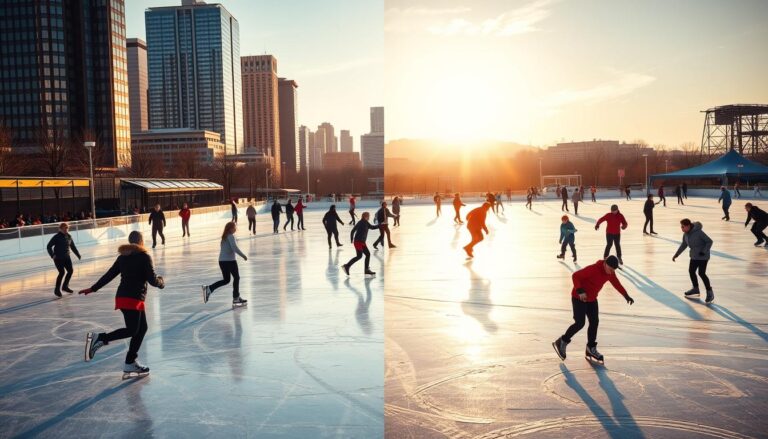Is Roller Skating Harder Than Ice Skating? Depends On Several Factors
Imagine standing at the threshold of a smooth surface, skates ready, anticipation building. The question echoing in your mind: is roller skating harder than ice skating? This debate has intrigued skating enthusiasts for generations, challenging athletes to explore the nuanced world of gliding and sliding.
Roller skating and ice skating present unique challenges that test an individual’s balance, coordination, and athletic prowess. Understanding the skill level differences between these two disciplines requires a deep dive into their technical aspects, surface interactions, and physical demands.
Whether you’re a fitness enthusiast seeking a new workout or an adventure seeker looking to master a dynamic sport, comparing roller skating vs ice skating skill level becomes critical. Each skating style demands specific techniques, muscle engagement, and mental focus that set them apart.
Professional athletes and recreational skaters alike recognize that the difficulty of skating isn’t universal. Factors like surface type, equipment, personal fitness, and prior experience dramatically influence your learning curve and performance.
In this guide, we’ll break down the differences between roller and ice skating. You’ll discover insights that help you understand which skating style might align best with your physical abilities, athletic goals, and personal preferences.
Prepare to unravel the mysteries of skating mechanics, explore the unique challenges of each discipline, and gain expert-level understanding of what makes roller skating and ice skating distinctively demanding. Your journey to becoming a skilled skater starts here!
Understanding the Fundamental Differences Between Roller and Ice Skating
Skating fans know that roller and ice skating look similar at first. But they have unique features that make them different. Exploring roller skating shows a world of special gear, how it interacts with surfaces, and unique ways to move.
For beginners and pros, knowing the main differences is key. Each type needs its own skills and equipment, making the experience unique.
Basic Equipment and Gear Comparison
The main differences in equipment are clear:
- Roller Skates:
- Four-wheel setup
- Wheels made of rubber or polyurethane
- Meant for moving on solid surfaces
- Ice Skates:
- Has a metal blade
- Boot is stiff
- Best for gliding on ice
Surface Types and Their Impact
The surface you skate on changes everything. Roller skates work on concrete or wood. Ice skates, on the other hand, glide on ice, changing how you move.
Movement Mechanics Overview
Roller skating and ice skating also differ in how you move. Roller skaters push with their wheels. Ice skaters use their edges and blades for speed.
| Skating Type | Propulsion Method | Surface Interaction |
|---|---|---|
| Roller Skating | Lateral push | Friction-based movement |
| Ice Skating | Blade edge gliding | Minimal surface resistance |
Knowing these differences helps you enjoy skating more, whether with roller skates or ice blades.
The Physics Behind Both Skating Disciplines
Skating is more than just balance and movement. It’s a dance with physics. Knowing the science behind roller and ice skating shows why each needs special skills.
Roller skates use wheel friction on solid ground. Ice skates, on the other hand, have a thin blade for less contact on ice. This small difference changes how each type of skating works.
- Roller skating friction depends on wheel hardness and surface texture
- Ice skating leverages minimal blade-ice contact for smooth gliding
- Momentum transfer varies significantly between wheels and blades
Roller skating faces different physics challenges than ice skating. Roller skaters deal with more friction, needing more muscle power. Ice skaters, with less friction, must control their weight and edges more precisely.
| Physics Factor | Roller Skating | Ice Skating |
|---|---|---|
| Surface Interaction | High friction | Low friction |
| Energy Transfer | More muscle power required | Smoother gliding motion |
| Balance Mechanics | Wider base of support | Narrow blade point |
Pro tip: Understanding these physics principles can help you adapt your technique and improve your skating performance!
Is Roller Skating Harder Than Ice Skating? Let’s Break It Down
Starting out in skating is an exciting challenge. Both roller and ice skating have their own hurdles for beginners.
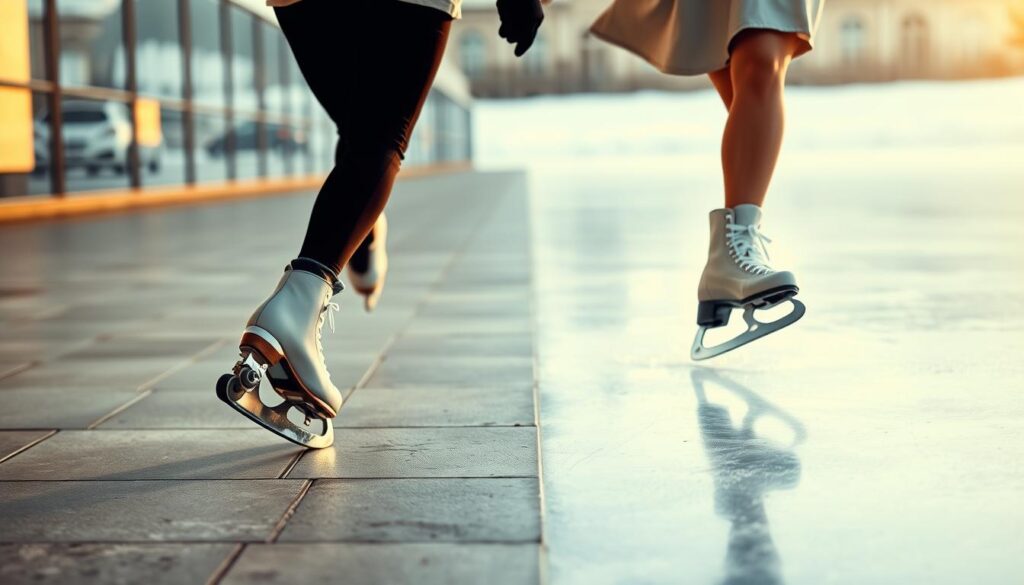
Figuring out which is easier depends on several important factors. These factors affect how easy it is for a new skater to learn.
Initial Learning Curve Analysis
Starting to skate can be scary, but there are big differences between roller and ice skating:
- Roller skates have more contact with the ground
- Ice skates need better balance on thin blades
- Indoor roller rinks are better for beginners
Balance and Control Factors
Getting balance right is key for new skaters. Roller skating is generally more stable because of wider wheels. Ice skating, on the other hand, requires strong core muscles and precision.
| Skating Type | Balance Difficulty | Control Complexity |
|---|---|---|
| Roller Skating | Moderate | Easier |
| Ice Skating | High | More Challenging |
Speed and Momentum Differences
The way you glide changes a lot between surfaces. Roller skates give more friction, making it easier to control speed. Ice skating, though, needs a better understanding of edge control and managing momentum.
Your athletic background, flexibility, and how you handle falls will decide which skating you prefer. The most important thing is to be patient, practice, and enjoy the learning journey.
Getting Started: First Steps on Wheels vs. Blades
Starting to skate is like entering a new world of movement. At first, roller skating and ice skating might seem scary. But with the right steps, you’ll soon be gliding with ease.
Your first moments on skates are key to building confidence. Both roller and ice skating need special techniques for beginners. These help you find your balance and get moving.
- Roller Skating First Steps:
- Start with a stable stance
- Keep feet shoulder-width apart
- Bend knees slightly for better balance
- Ice Skating Initial Techniques:
- Use skating aids if available
- Practice marching movements
- Learn to distribute weight evenly
Knowing the differences between roller and ice skating helps you start right. Roller skates offer more surface contact, making balance easier. On the other hand, ice skates need precise weight distribution.
Remember, falling is part of learning. Wear protective gear, stay relaxed, and know that every pro started where you are.
Mastering Balance: Different Techniques for Each Sport
Balancing on roller skates and ice skates needs special skills. The roller skating and ice skating comparison shows how skaters stay stable on different surfaces.
Knowing your body’s center of gravity is key for both sports. Each sport has its own balance strategies. These strategies challenge athletes in different ways.
Center of Gravity Adjustments
Roller skating needs a more active balance than ice skating. How you distribute your weight is very important for staying stable:
- Roller skates require constant small adjustments
- Ice skates let for smoother gliding
- Surface friction affects balance differently
Weight Distribution Methods
Skaters must learn special weight transfer techniques for their chosen surface. Roller skating is harder because of the unpredictable ground. Ice skating is easier because of the controlled glide.
| Skating Type | Balance Technique | Key Challenge |
|---|---|---|
| Roller Skating | Wider stance, frequent weight shifts | Managing wheel friction |
| Ice Skating | Narrow stance, edge control | Maintaining blade precision |
Pro tip: Practice balance exercises off the skating surface to improve your core strength and stability across both disciplines.
Common Challenges for Beginner Roller Skaters
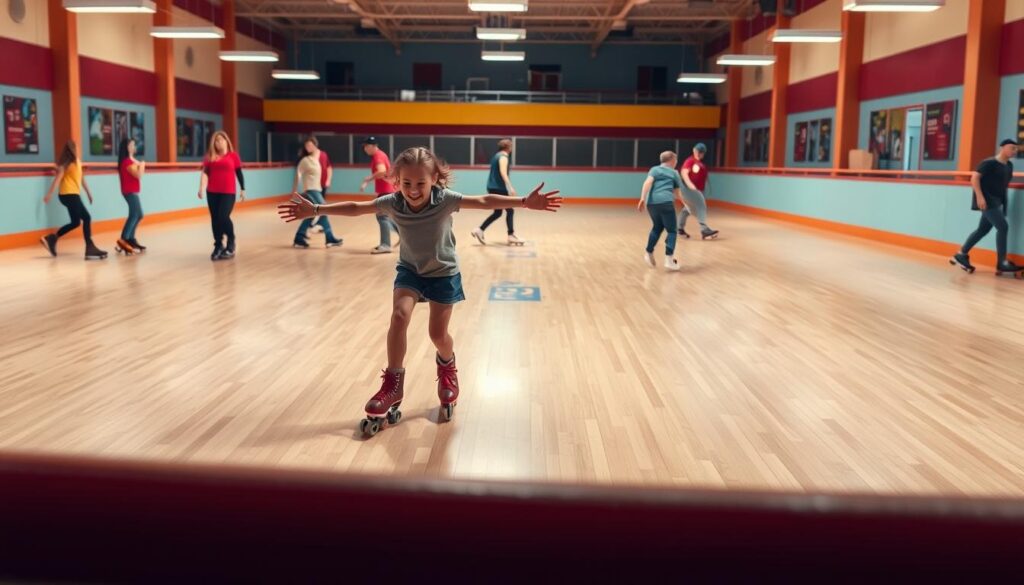
Starting roller skating can feel like a wild ride. Beginners face unique challenges that test their balance, confidence, and willpower. Both roller and ice skating need patience and practice to get the hang of them.
Here are the main hurdles beginners hit when they first step on roller skates:
- Balance Instability: Roller skates have a wider base than ice skates. This makes the first steps feel awkward and hard to predict.
- Stopping techniques that need precise body control.
- Managing the fear of falling on harder surfaces.
- Developing muscle memory for smooth transitions.
The mental game is key in beating roller skating challenges. Many beginners struggle with:
- Feeling confident in public skating areas.
- Getting over the fear of looking clumsy.
- Building muscle strength for roller skating moves.
Roller skating is different from ice skating because it needs quick weight shifts and awareness of the ground. Success comes from embracing the learning journey and practicing often.
Pro tip: Begin in a safe place like an empty parking lot or a skating rink. Wear protective gear and aim for small, steady improvements. This will help build your skills and confidence.
Typical Obstacles New Ice Skaters Face
Stepping onto the ice for the first time can feel intimidating. The slippery surface and unfamiliar equipment create unique challenges for beginners. Understanding these obstacles helps new skaters build confidence and progress more effectively.
Overcoming Initial Fear
Many new ice skaters experience significant anxiety when first attempting to glide. The fear of falling can paralyze even the most enthusiastic learner. To manage this challenge, consider these strategies:
- Wear protective gear (helmet, wrist guards, knee pads)
- Start near the rink wall for support
- Take lessons from a professional instructor
- Practice balance exercises off the ice
Building Confidence on Ice
Developing confidence requires patience and consistent practice. When comparing which is easier between roller skating or ice skating, ice skating often demands more initial mental preparation.
| Confidence-Building Technique | Difficulty Level | Practice Frequency |
|---|---|---|
| Wall Support Skating | Beginner | First 1-2 Sessions |
| Basic Gliding | Intermediate | 3-5 Sessions |
| Independent Skating | Advanced | 6-10 Sessions |
Remember, every professional skater started exactly where you are now. Embrace the learning process and stay patient with yourself as you develop new skills on the ice.
Learning Curves: Time Investment Comparison
Learning to skate on wheels or ice takes different amounts of time and effort. Knowing how each sport’s learning curve works helps set better goals for your skating adventure.
At first, roller skating seems easier for beginners. The solid ground and bigger wheels give you more confidence. Ice skating, on the other hand, requires better balance and technique right away.
- Roller Skating Learning Curve:
- Basic balance: 1-2 weeks
- Comfortable movement: 3-4 weeks
- Advanced techniques: 3-6 months
- Ice Skating Learning Curve:
- Basic balance: 2-3 weeks
- Comfortable movement: 4-6 weeks
- Advanced techniques: 6-12 months
Is roller skating harder than ice skating? It’s not always true. Each sport has its own challenges. Your fitness level, past sports experience, and how often you practice also play big roles in how fast you learn.
Pro tip: Cross-training between roller and ice skating can speed up your skill growth. It helps you get used to different skating settings faster.
Being consistent in your practice is key. Regular sessions, good lessons, and your own hard work will help you improve faster in either sport.
Safety Considerations for Both Skating Types
Skating has its own risks, whether on wheels or blades. Knowing the safety needs of roller and ice skating helps you stay safe and have fun.
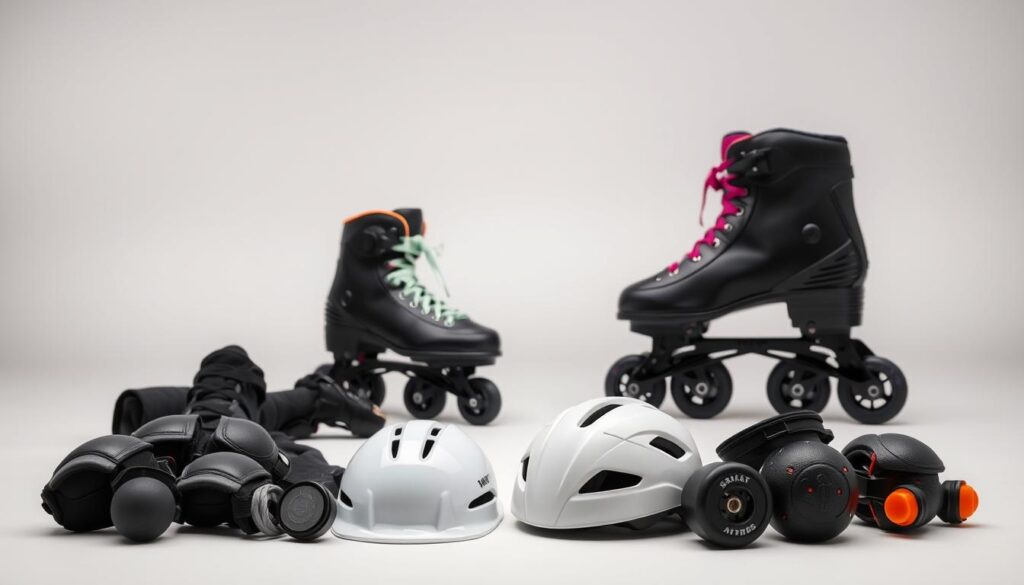
Roller skating and ice skating have different safety needs. Each one requires special safety steps to avoid injuries.
Protective Gear Requirements
Your safety gear changes between roller and ice skating. Here’s what you need:
- Helmet (critical for both disciplines)
- Wrist guards to prevent fractures
- Knee and elbow pads
- Padded shorts for additional protection
| Gear Type | Roller Skating | Ice Skating |
|---|---|---|
| Helmet | Multi-impact design | Lightweight racing style |
| Padding | Thick, shock-absorbing | Slim, flexible protection |
| Recommended Usage | Always for beginners | Recommended for advanced techniques |
Environmental Risk Factors
The surface you skate on affects your safety. Roller skating is usually on smooth, controlled areas. Ice skating, on the other hand, has more unpredictable surfaces.
- Roller rinks: Controlled environment with predictable surfaces
- Ice rinks: Variable ice conditions requiring constant adaptation
- Outdoor surfaces introduce additional challenges for both disciplines
Experts say learning how to fall safely and wearing good gear is key. Your safety depends on being prepared and knowing the risks of each skating type.
Skill Progression: From Basic to Advanced Moves
Learning roller skating and ice skating needs a careful plan. Roller skating has its own set of challenges, unlike ice skating. Both require hard work and a clear learning path.
Starters will learn basic skills in stages:
- Balance and stance basics
- How to move forward
- Stopping and steering
- More complex footwork and control
Ice skating has its own learning path. Roller skaters find moving sideways easier, while ice skaters work on precise edge control. Each sport needs its own muscle memory and technique improvement.
Key milestones for both skating types are:
- Beginner: Basic forward skating
- Intermediate: Backward skating and crossovers
- Advanced: Complex turns and special moves
- Expert: Performance and competitive skills
Those aiming to get better should practice regularly, focus on proper technique, and slowly add new skills. Knowing the unique challenges of roller skating helps in planning training.
Experts suggest breaking down hard moves into simpler parts. This method lowers frustration and boosts confidence in both roller and ice skating.
Cross-Training Benefits Between Both Disciplines
Skaters looking to get better at their sport are finding a cool way to do it. They’re trying out cross-training between roller skating and ice skating. These two sports share some key similarities that can really boost your skills.
When athletes move from one sport to the other, they notice big improvements. The skills they learn in one sport, like balance and edge control, help a lot in the other. This makes them better overall.
Transferable Skills That Enhance Performance
By cross-training, skaters can see amazing gains. They learn skills that are useful in both sports. These include:
- Balance and weight distribution techniques
- Edge control and precision movement
- Core strength and muscular coordination
- Spatial awareness and quick reflexes
Complementary Techniques for Skill Acceleration
Training in both roller and ice skating is a great way to get better. Muscle memory from one sport helps in the other. For example, roller skating’s side-to-side moves make ice skating’s crossovers better.
Coaches and pros know that trying new things keeps training exciting. Switching between roller and ice skating keeps athletes motivated and pushes their limits.
Whether you’re in it to win or just for fun, cross-training is a game-changer. It makes you better and more fun to watch.
Impact of Age and Physical Condition on Learning
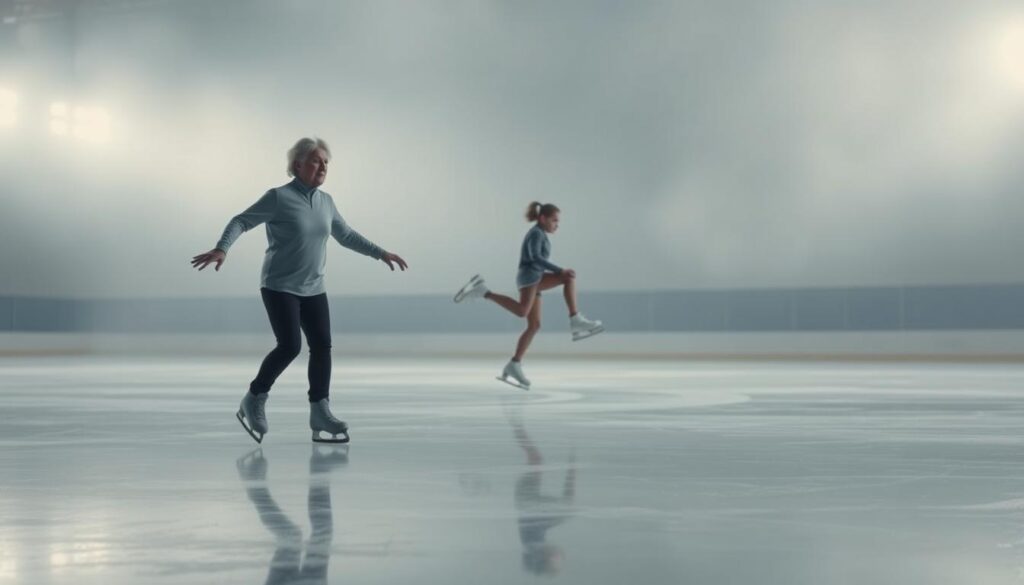
Are you curious about which is easier, roller skating or ice skating, for different ages? Your physical shape is key in learning either sport. Age is not a big deal; it’s more about your fitness and how you approach it.
Every age group faces unique hurdles when starting to skate. Young people usually have better flexibility and quicker muscle memory. This makes starting out in roller skating or ice skating a bit easier for them.
- Teens and young adults: Peak physical condition for quick skill acquisition
- Middle-aged learners: Require more focused balance training
- Seniors: Can excel with proper technique and gradual progression
Your fitness level greatly affects your skating journey. Core strength, leg muscles, and flexibility are key to mastering skating skills. Roller skating might be easier for beginners because it’s on a stable surface. Ice skating, on the other hand, is slippery.
| Age Group | Roller Skating Ease | Ice Skating Difficulty |
|---|---|---|
| 13-25 years | Very Easy | Moderate |
| 26-45 years | Moderate | Challenging |
| 46-65 years | Challenging | More Difficult |
Experts say start with roller skating if you’re new. It’s easier to progress, helping beginners build confidence step by step.
It’s your attitude that counts more than your age. With the right training, practice, and patience, anyone can become a skilled skater, no matter their physical shape.
Cost Comparison: Equipment and Practice Venues
Starting in the world of skating means looking at the money needed for roller and ice skating. The costs for each sport show how different they are.
Here are the main expenses you’ll face:
- Initial Equipment Costs
- Roller Skates: $50-$250 for beginners
- Ice Skates: $100-$500 for entry-level models
- Protective Gear
- Roller Skating: Helmet, knee pads, elbow pads
- Ice Skating: Specialized padding and warm clothing
Costs for where you skate also differ a lot. Roller rinks usually charge $5-$10 per session. Ice rinks often cost more, from $10-$20, based on where you are and when you go.
To save money, you can:
- Buy used equipment
- Look for discounts at community centers
- Get annual memberships
- Skate during less busy times
Roller skating and ice skating also have different long-term costs. Replacing roller skate wheels is cheaper than sharpening ice skate blades. This makes roller skating more affordable to keep up with.
Tip: Think about your area’s weather and skating spots when picking between roller and ice skating. Some places make one sport cheaper and easier to get to.
Professional Training Options for Both Sports
Skating fans wanting to get better can look into professional training. This training helps with both roller and ice skating. Each sport has its own way of learning.
Professional training for roller and ice skating gives special help. It helps athletes deal with specific problems. There are many ways to train:
- Group classes for beginners
- Private one-on-one coaching
- Specialized workshops
- Intensive training camps
Choosing the right instructor is key. Good coaches have gone through a lot of training. They know how to handle the challenges of both roller and ice skating.
| Training Type | Roller Skating Focus | Ice Skating Focus |
|---|---|---|
| Beginner Lessons | Balance on wheels, stopping techniques | Edge control, basic gliding |
| Advanced Training | Complex dance moves, speed techniques | Jumps, spins, competitive routines |
| Certification Level | USARS Instructor Certification | U.S. Figure Skating Coach Ratings |
Think about your goals, skill level, and what you want to achieve. Professional instruction can really help you improve. It offers tailored advice and expert guidance.
- Research local skating clubs
- Check instructor credentials
- Attend introductory classes
- Evaluate your progress regularly
Whether you love roller skating or ice skating, professional training can help. It’s a way to get better at these fun sports. Invest in good training to reach your goals and tackle the challenges each sport brings.
Conclusion
Roller skating and ice skating are not about picking one over the other. The difficulty depends on your skills, goals, and passion. Each sport has its own challenges and benefits that can change your fitness journey.
Don’t let fear hold you back from trying something new. Whether you prefer the smooth roll of wheels or the precise glide of blades, both sports offer great opportunities. Your experience will depend on your balance, practice, and where you skate.
Skating pros and fans say the most important thing is to have fun. Start with beginner classes, wear the right gear, and enjoy learning. The skating world has something for everyone, from casual skaters to competitive athletes.
Your skating adventure starts with a single step or roll. Grab your skates, find a local rink, and explore. Whether you choose roller or ice skating, you’re on a path of skill, challenge, and joy. Remember, your only limit is what you think you can do.

